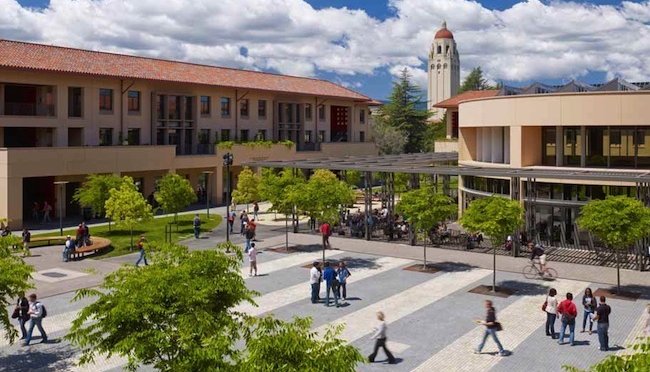
Jide, ex-KPMG, ex-Vetiva, ex-Renaissance Capital, is the Sub Saharan African Markets Risk & Financial Services Leader of Talentstone Africa Partners. He’s a 2005 graduate of Obafemi Awolowo University, Ile Ife, Nigeria.
Yale University’s School of Management continued its upward momentum in the rankings by rising seven places to finish 11th in the new biennial ranking of the best MBA programs published on Wednesday (Sept. 9, 2015) by Forbes magazine. UC-Berkeley’s Haas School of Business and The University of Texas’ McCombs School also scored substantial gains, rising six and seven places, respectively, to ranks of 8th for Berkeley and 14th for UT.
But the biggest winner yet again was Stanford University’s Graduate School of Business, a school that seems to be in the right place at the right time. In the middle of what some people are worrying is now a tech bubble, Stanford claimed undisputed possession of first place with the highest return-on-investment of any two-year MBA program in the world. For Stanford, it was the second consecutive No. 1 ranking from Forbes and the third in the nine editions of the ranking dating back to 1999. Only its perennial East Coast rival Harvard Business School, No. 2 this year, has claimed first place more often: four times.
Rounding out the top five schools are No. 3 Northwestern University’s Kellogg School of Management, No. 4 Columbia Business School, and No. 5 Dartmouth College’s Tuck School of Business, the only other school besides Harvard and Stanford to ever win first place in the Forbes ranking. Tuck won it twice in 2007 and 2005. Kellogg improved its standing by two spots, while Columbia moved up three places, and Tuck edged up one.
THE BEST ROI FOR AN MBA DEGREE ANYWHERE IN THE WORLD? INSEAD
Though no MBA graduates are earning more money five years out than Stanford, several European schools turned out even better ROI numbers. In the category of one-year international MBA programs, INSEAD topped the list with a five-year MBA gain of $171,200, resulting in a 2.4-year payback on the degree. That compares with a 4.2-year payback on the Stanford diploma. INSEAD was followed by No. 2 IMD, No. 3 Cambridge University, No. 4 SDA Bocconi in Italy, and No. 5 IE Business School in Spain.
London Business School, meantime, topped Forbes’ two-year international list, with a five-year MBA gain of $102,100, resulting in a 3.7-year payback. Entering LBS students left annual salaries of $78,000 and now report making $210,000 a year in total compensation, five years after graduation. London was followed by No. 2 IESE in Spain, No. 3 HEC Paris, No. 4 CEIBs in China, and No. 5 Hong Kong University of Science and Technology.
Forbes routinely publishes three separate rankings every two years: One for two-year U.S. programs, another for two-year international programs and a final one for one-year international programs which tend to be more popular outside the U.S. One-year programs hold an obvious advantage when it comes to crunching ROI because students only lose one year of pay to get the degree and only have to pay one year’s worth of tuition. For the non-U.S. schools, Forbes convert the gains reported by students in their local currency and then uses an average exchange rate over the past five years to report the totals in U.S. dollars.
CHICAGO BOOTH AND WHARTON BOTH FALL OUT OF THE TOP FIVE
Perhaps the biggest surprise at the top of the rankings was the decline of both the UPenn’s Wharton School to seven place, a fall of three spots from fourth in 2013, and the University of Chicago’s Booth School of Business, which fell four places to sixth from second last time around. It would be tempting to suggest that schools which guide more MBA grads into finance might have taken a bigger hit in this ROI measurement which is based on more than 4,000 responses from the Class of 2010. But gains by other schools, such as Columbia and New York University’s Stern School, that are largely dependent on Wall Street and finance, would prove that theory false.
Unlike other MBA lists that often use a wide variety of metrics to rank schools, the Forbesmethodology produces a ‘Show-Me-The-Money’ ranking based solely on return on investment. The magazine gathers all its rankings data from alumni, comparing graduates’ earnings in their first five years after graduation to their opportunity costs, including two years of lost income, tuition and fees, to calculate a five-year MBA gain. All the schools are ranked on the average five-year MBA gain for the Class of 2010, a tough year to enter what was a still troubled job market in the wake of the Great Recession.
Forbes said it had a 24% response rate on its surveys to 17,400 alumni at 95 schools. Schools with response rates under 15% were excluded from the rankings as were schools where alumni reported a negative ROI after five years. The magazine adjusts the median five-year gains
for cost-of-living expenses and discounts tuition to account for students who pay in-state rates and for scholarships and non-repayable financial aid. Bottom line: If the graduates reporting the numbers are telling the truth, this is a fairly good set of data to judge the worth of an MBA degree.
STANFORD MBAS TRIPLED THEIR PRE-MBA TOTAL COMPENSATION TO $255,000 A YEAR
Out of the 65 two-year U.S. business schools ranked by Forbes this year, Stanford MBAs reported the highest average gains at $89,100. That may seem puny on the face of it, but those gains came after subtracting out the big investment required for an elite two-year MBA program. The results are far more impressive: Stanford’s Class of 2010 tripled their pre-MBA total compensation to $255,000 five years out of school, up from $221,000 reported two years ago by the Class of 2008. The total comp numbers include base salary, bonus and exercised stock options, which no doubt, pushed Stanford’s numbers higher. Forbes noted that Stanford grads made 5½ times the average U.S. per capita income last year of $46,129.
To put that into more of an MBA perspective, incoming Stanford MBAs were making only $3,000 a year more than those at Wharton. Five years after graduation, the West Coast grads were pulling down $48,000 a year more than Wharton MBAs whose annual compensation last year was $207,000.
What’s more, because Forbes asks MBA graduates directly for this information, it often includes data that schools decline to disclose. In Stanford’s case, students who entered the program in 2008 reported making the highest incoming salaries for any MBA program, $86,000, a sum that is a strong indicator of the quality of the students and the jobs they already had. The school’s top employers were Bain & Co., Boston Consulting Group, Google and McKinsey & Co.
SOME 37% OF STANFORD’S CLASS OF 2010 REPORTED HAVING STOCK OPTIONS WORTH $250,000 EACH
Even more impressive, 37% of Stanford’s Class of 2010 reported getting stock options with a median value of $250,000. Total compensation, excluding options, increased 16% annually on average since graduation for Stanford’s class of 2010. No school had a higher growth rate. In fact, the average for the top 25 U.S. schools is 9.3% a year.
For Yale’s School of Management, this latest gain comes on top of improved rankings from bothBloomberg Businessweek and The Financial Times. For the first time, Yale moved into the top ten on those other two lists. While Yale’s No. 11 status on this year’s Forbes list is big improvement over the school’s 18th place showing two years ago, it’s still far behind its highest ranking ever from the magazine. In both 2005 and 2003, Yale was ranked fifth by Forbes.
Besides Yale, Haas, and UT gains, other significant winners this year include the MBA programs at Notre Dame’s Mendoza School and Texas A&M’s Mays School. Both programs rose six places on the Forbes list to rank 23rd and 24th, respectively. Kellogg’s move up right behind Stanford and Harvard and well above Chicago-metro rival Booth is big news for the Evanston, Ill., school. NYU’s Stern School, in the midst of Wall Street’s collapse, gained five places to rank 18th, a big improvement over its 23rd place showing two years ago.
THE BIG WINNERS AND THE BIG LOSERS
There were even some bigger increases further down in the ranks. UC-Irvine’s Merage School of Business jumped 19 places to finish 42nd in the survey, though at that rank the five-year MBA gain was only $36,700–just 41% of Stanford’s No. 1 total. Merage MBAs reported making $139,000 five years after graduation–54.5% of what Stanford’s MBAs are pulling down. The University of Georgia’s Terry School, Arizona State University’s Carey School and the University of Alabama’s Manderson School all jumped 13 places each to rank 36th, 47th, and 49th, respectively.
And the losers? The largest Top 25 decline was suffered by the University of Michigan’s Ross School, which slid five spots to rank 15th from 10th in 2013. Duke University’s Fuqua School, riding high on its No. 1 Bloomberg Businessweek ranking from last year, fell four places to a rank of 12th this year from eighth two years ago. Georgetown University’s McDonough School of Business also plunged eight places–more than any Top 50 school–to a rank of 41st from 33rd in 2013.
Obviously, the ups and downs on this list are directly correlated with the returns reported by graduates. But for anyone who follows the rankings, it’s just an up-and-down roller coaster ride. Unlike most of the other rankings by U.S. News, Businessweek, The Financial Times, and The Economist, the Forbes methodology tends to produce fewer big swings from one ranking to the next. This year, for example, only five, or 10%, out of the Top 50 schools had double-digit increases or decreases.
RETURN-ON-INVESTMENT DECLINED OVERALL FOR THE CLASS OF 2010
There also was some sobering news in the data collected by Forbes, though it is in the context of the Class of 2010 which fell into the job market at a difficult time. The magazine noted that the average five-year gain at the Top 25 schools was $61,700, down from $68,000 two years ago and $118,000 in 2003. “An MBA is still a good proposition at an elite school, but the increasing cost is making it harder to justify the hefty investment in a post-financial crisis world,” concluded Forbes. “Students are leaving school with more and more debt. The average debt load for students reporting debt to Forbes from the class of 2010 was $80,000 compared to $65,000 two years earlier.”
Data Source: Forbes
** Photo Credits: Ethan Baron (Stanford Graduate School of Business)
+++
For more articles on careers and mentorship, subscribe free to JarusHub
[subscribe2]
ENROLL FOR JARUSHUB INTERNET & SOCIAL MEDIA OPPORTUNITIES MASTERCLASS OR CHECK OUT JARUSHUB SERVICES & PRODUCTS
Attend JarusHub Employability and Career Advancement Class and get ahead in your career!
SEE ALSO JARUSHUB CAREER GUIDE
Established in March 2013, JarusHub is a Nigerian information hub with focus on career and management. It is rated Nigeria's most authoritative destination for online career resources. It parades an array of Nigerian professionals who share their career experiences with a view to bridging career information gap and mentoring a generation to success. JarusHub has revolutionised career information and experience sharing in Africa. Whether you're a student, a recent graduate or an established professional, or even an executive, you will always find something to learn on JarusHub. All enquiries to jarushub@gmail.com or 0808 540 4500. Facebook: www.facebook.com/jarushub; Twitter: @jarushub or @mcjarus.
Career Q&A with Jarus: Oil & gas career, poor CGPA
September 17, 2023What is Career Counselling? How to choose the Right Career?
October 24, 2022
Let us have your say by leaving a comment belowCancel reply
Recommended For You
-
Take This Advice and Don’t Be a Job Seeker
June 27, 2016 -
Bridging the Leadership Gap: The Missing Link
December 17, 2013 -
How do I move into senior management cadre?
January 2, 2014





